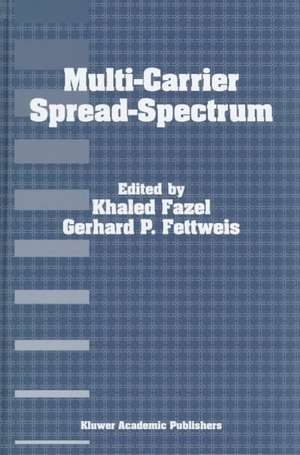Multi-Carrier Spread-Spectrum
Autor Khaled Fazel Editat de K. Fazel, Gerhard P Fettweisen Limba Engleză Hardback – 31 aug 1997
The advantages of the spread spectrum technique are: High immunity against multipath distortion, no need for frequency planning, high flexibility and easier variable rate transmission etc. On the other hand, the technique of multi-carrier transmission has recently been receiving wide interest for high data rate applications. The advantages of multi-carrier transmission are the robustness in the case of frequency selective fading channels, in particular the reduced signal processing complexity by equalization in the frequency domain, and in the capability of narrow-band interference rejection.
The advantages and success of multi-carrier (MC) modulation and the spread spectrum (SS) technique has led to the combination of MCM with SS, known as multi-carrier spread-spectrum (MC-SS) for cellular systems. This combination, benefits from the advantages of both schemes: Higher flexibility, higher spectral efficiency, simpler detection techniques, narrow band interference rejection capability, etc. Multicarrier-Spread-Spectrum comprises a collection of papers which collectively provide a state-of-the-art overview of this emerging multiple access scheme. It will be a valuable reference for all researchers and practitioners working on the area of wireless communications and networking.
Preț: 583.67 lei
Preț vechi: 686.68 lei
-15% Nou
Puncte Express: 876
Preț estimativ în valută:
111.70€ • 116.19$ • 92.21£
111.70€ • 116.19$ • 92.21£
Carte tipărită la comandă
Livrare economică 14-28 aprilie
Preluare comenzi: 021 569.72.76
Specificații
ISBN-13: 9780792399735
ISBN-10: 0792399730
Pagini: 264
Dimensiuni: 160 x 241 x 20 mm
Greutate: 0.57 kg
Editura: Springer
ISBN-10: 0792399730
Pagini: 264
Dimensiuni: 160 x 241 x 20 mm
Greutate: 0.57 kg
Editura: Springer
Cuprins
I. General Issues of Multi-Carrier Spread-Spectrum. Multi-Carrier Spread-Spectrum: An Attractive Special Case of General Multiuser/Multisubchannel Transmission Methods; J. Lindner Overview of the Results About Multi-Tone CDMA Detection; L. Vandendorpe. Comparison of Multiple Access Schemes for an OFDM Downlink System; H. Rohling, et al. Link/System Level Performance of an OFDM/CDMA Downlink Configuration; J.P. Castro, et al. II. Applications of Multi-Carrier Spread-Spectrum. Performance Analysis of a New Multi-Code and Multi-Carrier Hybrid Transmission Scheme for Future Broadband Mobile Communication Systems; H. Harada, R. Prasad. A Spread-Spectrum Multi-Carrier Multiple-Access System for Mobile Communications; S. Kaiser, K. Fazel. Orthogonal Frequency-Division Multiple-Access with Frequency Hopping and Diversity; H. Sari. M-ary Orthogonal Modulation for MC-CDMA Systems in Indoor Wireless Radio Networks; A. Dekorsy, K.-D. Kammeyer. Comparison of WLAN Multi-Carrier DS-SS Physical Layer Configurations Measured Indoor Environment; P. Banelli, et al. III. Coding and Detection for MC-SS. Multi-Carrier CDMA Using Convolutional Coding and Interference Cancellation over Fading Channels; J.J. Maxey, R.F. Ormondroyd. An Approach for a Multi-Carrier Spread-Spectrum System with RAKE Receiver; A. Nahler, G.P. Fettweis. Multi-Carrier Modulated Orthogonal Code-Division Multiple-Access: D.Th. Magill. Interleaved FDMA - A New Spread-Spectrum Multiple-Access Scheme; U. Sorger, et al. Aspects on Wideband Multi-Carrier Communication; J.E.M. Nilsson. Equalization and Coding for Extended MC-CDMA over Time and Frequency Selective Channels; J. Egle, et al. Detection Method for MC-CDMA Based on a Recurrent Neural Network Structure; W.G. Teich, et al. IV. Synchronisation and Channel Estimation. Sensitivity of OFDM/CDMA to Carrier Phase Jitter; H. Steendam, M. Moeneclaey. Time Domain Uplink Channel Estimation in Multi-Carrier CDMA Mobile Radio System Concepts; B. Steiner. Subspace-Based Joint Time-Delay and Frequency-Shift Estimation in Multi-Tone Code Division Multiple Access (MT-CDMA) Systems; M. Eric, et al. Pilot-Symbol-Aided Channel Estimation in Time and Frequency; P. Hoeher, et al. A Family of Extended Gaussian Functions with a Nearly Optimal Localization Property; Ch. Roche, P. Siohan. On the Duality of Multi-Carrier Spread-Spectrum and Single-Carrier Transmission; K. Brueninghaus, H. Rohling. Mismatched Multi-Carrier Complementary Spread-Spectrum Radar and Sonar Systems; I.S. Simic, et al. V. MC-SS for the Uplink of a Cellular System. An OFDM/SFH-CDMA Transmission Scheme for the Uplink; L. Tomba, W. Krzymien. Uplink Spectral Efficiency of Multi-Carrier Joint Detection Code-Division Multiple-Access Based Cellular Radio Systems; F. Berens, et al. Simulation of a DSSS/MCM System in a Doppler Spread Channel; T.B. Welch, R.E. Ziemer. On the Performance of Asynchronous Multi-Carrier CDMA; H. Ochiai, H. Imai. Performance Comparison B.
